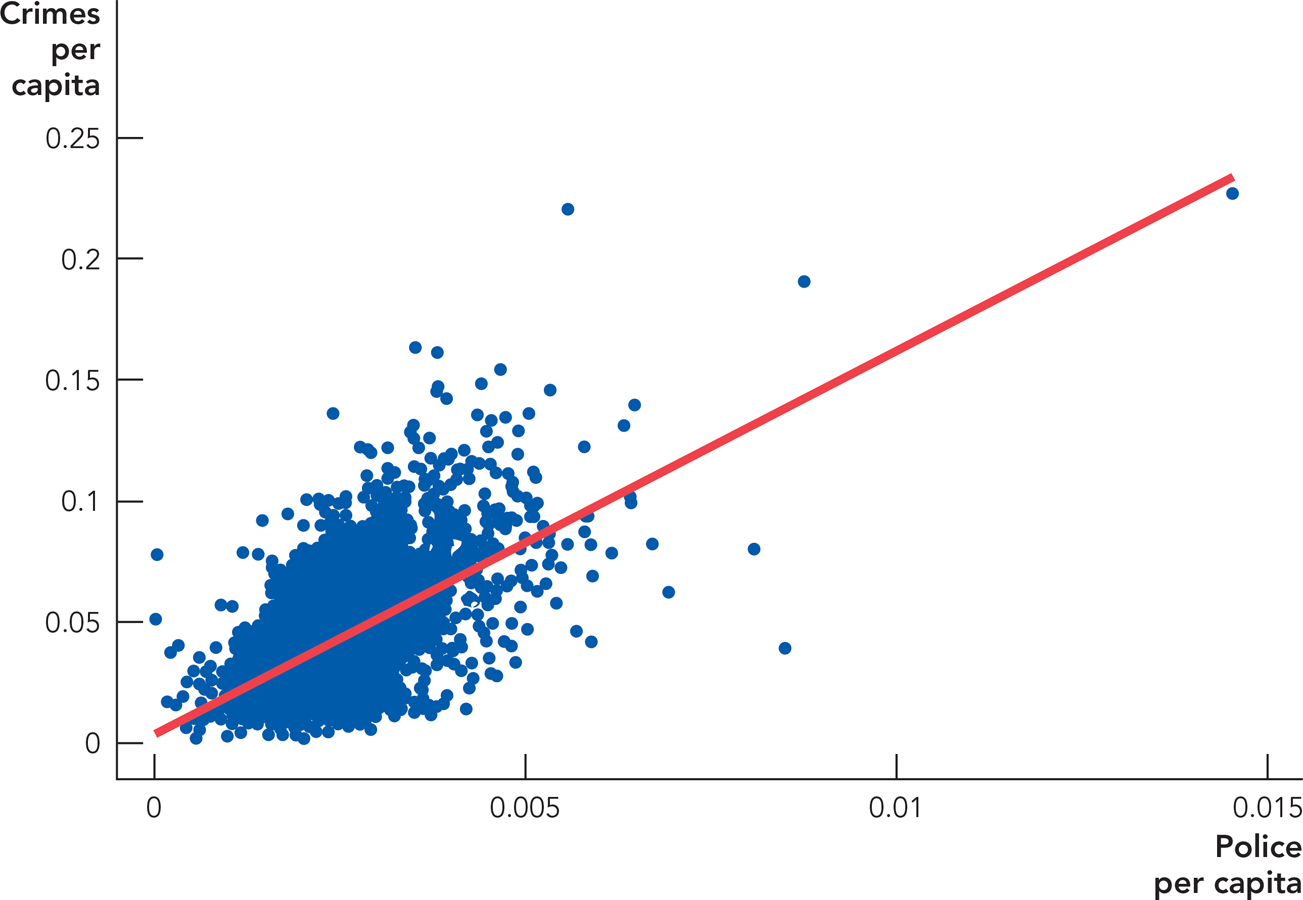Cause and Effect
Do police reduce crime? If so, by how much? That’s a key question that economists and criminologists are interested in understanding because local governments (and taxpayers) spend billions of dollars on police every year and would like to know whether they are getting their money’s worth. Should they spend less on police or more? Unfortunately, it’s surprisingly difficult to answer this question. To illustrate why, Figure A.11 shows the relationship between crime per capita and police per capita from across a large number of U.S. cities.
FIGURE A.11

Figure A.11 shows that cities with more police per capita have more crime per capita. Should we conclude that police cause crime? Probably not. More likely is “reverse causality,” crime causes police—that is, greater crime rates lead to more hiring of police. We thus have two chains of potential cause and effect, more police reduce crime and more crime increases police. Unfortunately, you can’t tell much about either of these two potential cause-and-effect relationships by looking at Figure A.11, which shows the correlation between police and crime but not the causation. But if you want to estimate the value of police, you need to know causation not just correlation. So what should you do?
The best way to estimate how much police reduce crime would be to take say 1,000 roughly similar cities and randomly flip a coin dividing the cities into two groups. In the first group of cities, double the police force and in the second group do nothing. Then compare crime rates over say the next year in cities with and without an increase in police. If the cities with an increase in police have lower rates of crime, then you can safely ascribe this difference to the effect of police on crime.What makes the correlation evidence in Figure A.11 difficult to interpret is that increases in crime sometimes cause increases in police. But if you increase the number of police randomly, you eliminate the possibility of this “reverse causality.” Thus, if crime falls in the cities that have random increases in police, the cause is most plausibly the increase in police. Similarly, if crime were to increase in cities that have random decreases in police, the cause is most plausibly the decrease in police.
Unfortunately, randomized experiments have at least one big problem—they are very expensive. Occasionally, large randomized experiments are done in criminology and other social sciences but because they are so expensive we must usually look for alternative methods for assessing causality.
If you can’t afford a randomized experiment, what else can you do? One possibility is to look for what economists call quasi-experiments or natural experiments. In 1969, for example, police in Montreal, Canada, went on strike and there were 50 times more bank robberies than normal.1 If you can think of the strike as a random event, not tied in any direct way to increases or decreases in crime, then you can be reasonably certain that the increase in bank robberies was caused by the decrease in police.
The Montreal experiment tells you it’s probably not a good idea to eliminate all police, but it doesn’t tell you whether governments should increase or decrease police on the street by a more reasonable amount, say 10 percent to 20 percent. Jonathan Klick and Alex Tabarrok use another natural experiment to address this question.2 Since shortly after 9/11, the United States has had a terror alert system run by the Department of Homeland Security. When the terror alert level rises from “elevated” (yellow) to “high” (orange) due to intelligence reports regarding the current threat posed by terrorist organizations, the Washington, D.C. Metropolitan Police Department reacts by increasing the number of hours each officer must work. Because the change in the terror alert system is not tied to any observed or expected changes in Washington crime patterns, this provides a useful quasi-experiment. In other words, whenever the terror alert system shifts from yellow to orange—a random decision with respect to crime in Washington—the effective police presence in Washington increases. Klick and Tabarrok find that during the high terror alert periods when more police are on the street, the amount of crime falls. Street crime such as stolen automobiles, thefts from automobiles, and burglaries decline especially sharply. Overall, Klick and Tabarrok estimate that a 10 percent increase in police reduces crime by about 3 percent. Using these numbers and figures on the cost of crime and of hiring more police, Klick and Tabarrok argue that more police would be very beneficial.
Economists have developed many techniques for assessing causality from data and we have only just brushed the surface. We can’t go into details here. We want you to know, however, that in this textbook when we present data that suggests a causal relationship—such as when we argue in the international trade chapter that higher GDP leads to lower levels of child labor—that a significant amount of statistical research has gone into assessing causality, not just correlation. If you are interested in further details, we have provided you with the references to the original papers.